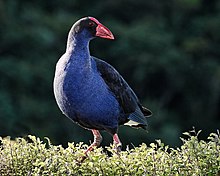Porphyrio melanotus
| Australasian swamphen | |
|---|---|
 |
|
| P. melanotus at Waikawa, Marlborough, New Zealand | |
| Scientific classification | |
| Kingdom: | Animalia |
| Phylum: | Chordata |
| Class: | Aves |
| Order: | Gruiformes |
| Family: | Rallidae |
| Genus: | Porphyrio |
| Species: | P. melanotus |
| Binomial name | |
|
Porphyrio melanotus (Temminck, 1820) |
|
| Synonyms | |
|
Porphyrio porphyrio melanotus |
|
Porphyrio porphyrio melanotus
The Australasian swamphen (Porphyrio melanotus) is a species of swamphen occurring in eastern Indonesia, the Moluccas, Aru and Kai Islands, as well as in Papua New Guinea and Australia. It is also found in New Zealand, where it is known as the pūkeko, a term derived from the Māori language. The Australasian swamphen used to be considered a subspecies of the purple swamphen.
The Australasian swamphen is found in mainland Australia, eastern Indonesia, the Moluccas, Aru and Kai Islands, and in Papua New Guinea. They are also found on New Zealand's main islands and in the Chatham and Kermadec Islands. It has a small shield, black upperparts, and a purple throat and breast. P. p. pelewensis (Hartlaub & Finsch, 1872) from Palau, resembles melanotus but has greener upperparts and is smaller. P. p. melanopterus (Bonaparte, 1856) is found from the Lesser Sundas and Moluccas to New Guinea. It is as melanotus but smaller, more variable and less blue in the upperparts. P. p. bellus (Gould, 1820) from West Australia is as melanotus but has a cerulean blue throat and breast. P. p. samoensis (Peale, 1848) occurs from New Guinea to New Caledonia and Samoa, and is as melanotus but smaller, with a brown tinge on the back
According to the Heather and Robertson Field Guide, the bird seems to have become established in New Zealand about 1000 years ago. According to Millener (1981), it invaded from Australia less than 1,000 years ago. It is also assumed to have spread from Australia to New Guinea. Some assume that it became established before humans in New Zealand, but all fossil occurrences are in sites younger than 400 years and there is no evidence that they were on the main islands of New Zealand before the Māori arrived (Worthy & Holdaway 1996). It may have been introduced by the ancestors of Māori. East Coast Māori say they were brought to New Zealand on the Horouta canoe which arrived about 24 generations ago. The Aotea tribe of the West Coast say the pūkeko was introduced by their ancestors in a boat called the Aotea.
...
Wikipedia
